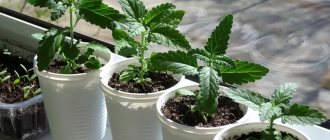Antirrinum, or snapdragon, is a subshrub plant with beautiful spike-shaped inflorescences. The flower is valued for its appearance and relative ease of care.
Dear readers! For you, we have created communities on social networks in which useful articles and interesting ideas are published several times a day! Subscribe and receive useful content in a convenient format!
The plant is used to decorate home areas and public gardens. The most effective is the seedling method of growing snapdragons.
How to prepare planting material for sowing
Before planting grains in the ground for growing Antirrinum seedlings, they are prepared. The preparation process usually includes 2 procedures: disinfection and stimulation.
You can disinfect the seeds by soaking them for half an hour in a pink solution of potassium permanganate or a solution of hydrogen peroxide (a teaspoon per glass of water).
Stimulation includes soaking planting material in a growth stimulator (Epin, hydrogen peroxide, Gumi, aloe juice, etc.).
Unlike other flowers, Antirrinum grains do not require long soaking. It is enough to keep the seeds in gauze soaked in a nutrient composition for just 2 hours.
When to sow snapdragon seedlings in 2022 according to the lunar calendar?
In our country, the calendar of agricultural work has long been associated with the lunar calendar. There are favorable days for planting, and there are unlucky days, when it is better not to carry out any work with plants, including growing seedlings.
Lucky days are those when the moon is waxing, and unlucky days are full and new moons. The days of the waning moon are considered neutral.
ON A NOTE. There is also a superstition that work cannot be carried out on those days of the month when the moon passes through the constellation Aquarius.
Favorable days for sowing snapdragons in 2022 depending on the month
Below is the time when it is best to plant snapdragons for growing seedlings in 2022 according to the lunar calendar:
- In January
— 6, 7, 16, 17, 21, 22, 23, 24, 25, 26 - In February
– 3, 4, 12, 13, 14, 17, 18, 19, 20, 21, 22, 23 - In March
– 11, 12, 13, 16, 17, 19, 20, 21, 22, 23, 24, 29, 30, 31 - In April
– 8, 9, 13, 14, 15, 17, 18, 26, 27 - In May
– 5, 6, 7, 10, 11, 12, 13, 14, 15, 23, 24
Care after landing
After 7-10 days, shoots form. The cover is removed from the boxes, and the seedlings are placed on a cool, bright windowsill. The temperature may drop to +18…20℃. Seedlings should not be left in direct sunlight, so it is better to place the seedlings on windowsills on the east side.
It is recommended to shade plants on the south side with gauze or tulle.
Watering is carried out with warm water. It should first sit for at least two days, during which all chlorine should be removed from its composition. Water is added carefully, trying not to get on the foliage and stems, as this will cause the seedlings to rot. Excess liquid has a negative effect on the condition of the seedlings. If the sprouts are too small, then it is more convenient to use a syringe or syringe to irrigate them.
If fertilizers have not been previously applied to the soil substrate, two weeks after emergence and a week after picking, the seedlings need to be fed. For this purpose, the following mineral complex fertilizers are used:
- Pokon;
- Kemira;
- Rainbow, etc.
When three full-fledged leaves are formed on the plants, this signals that it is necessary to pick. Plants from common containers are transplanted into individual containers. In this case, the stem should be carefully buried along the cotyledon. For transplantation, select pots whose height does not exceed 10 cm.
After the height of the plant reaches 10-12 cm, and 4-5 leaves are formed on it, it is recommended to pinch the tops of the seedlings. This will help awaken the sleeping side branches located in the sinuses. Lateral branches will form from them, which gives the plant fullness. You should not pinch the ampelous pharynx, as this will stop its growth.
10-15 days before transplanting, seedlings begin to harden. To do this, take it out into the fresh air. At first, she should not be on the street for long, but gradually the duration of her stay there should increase. At the end of hardening, the plants should be outdoors all day. It is important to try to avoid drafts.
In order to transplant snapdragons, select a site in lacy shade or in the light. Plants require loose soil with a neutral pH reaction. If the soil lacks nutrients, then the following fertilizing is applied per 1 square meter. m:
- 40 g superphosphate;
- 20 g potassium sulfate;
- 5-7 kg of humus.
Transplantation is carried out using the transshipment method, which preserves the integrity of the earthen coma. Depending on the height of the plant in adulthood, the distance between them should vary from 15 to 40 cm.
When you shouldn't plant flowers, bad days
Agronomists agree that it is impossible to carry out serious agrotechnical work, which includes, for example, sowing seeds, on the days of full and new moons, so you should not plant snapdragons on these days.
These days are considered unlucky for growing, and gardeners traditionally try not to disturb the plants.
- In January
— 1, 2, 3, 18
- In February
– 1, 2, 16 - In March
– 1, 2, 3, 18 - In April
– 1, 2, 16, 29, 30 - In May
– 16, 29, 30, 31
ON A NOTE. Some summer residents also do not work the day before and the day after these natural events.
Choosing the right soil
Tall varieties of snapdragons will be sown as seedlings in February. Summer residents should take care of purchasing soil in advance. Garden soil is too heavy for growing seedlings. The soil for sowing seeds should be loose, light and nutritious.
Of the ready-made primers, “Universal” or “Floral” are suitable. Such soil contains everything necessary for the active growth of seedlings; it is processed in production to make it safe for plants.
If you still decide to use garden soil, it is improved by adding 2 parts of peat and 0.5 parts of sand. The mixture will need to be disinfected by baking in the oven or steaming in the microwave. Prepare the soil 2 weeks before sowing. In the remaining time, the beneficial microflora will have time to recover.
When to plant antirrinum depending on the region?
The climatic conditions of the growing region have a decisive influence on the timing of sowing snapdragon seedlings.
- In Kuban and Crimea, grains can be planted from the first days of March;
- In the Black Earth Region, Volga region, Central Russia - in the 2-3rd decade of March;
- In the Leningrad region and Vologda region - the end of March;
- Ural, Siberia, Far East - early April.
Planting snapdragon seeds step by step
The algorithm for sowing Antirrinum seeds is simple and does not differ much from sowing other plants.
- Seed material is prepared and processed.
- Containers are being prepared. You can plant the plant in a common box (then you will need picking).
- The grains are slightly pressed into the ground. There is no need to cover it with soil afterwards.
- Next, the plantings are moistened and covered with air-tight material.
- The entire structure is placed in a warm place until shoots emerge.
How to care for snapdragon seedlings, any tricks?
From the moment the seedlings emerge, the stage of caring for seedlings at home begins. Young plants need to be provided with the conditions they need for growth and development.
The snapdragon seeds have sprouted, what to do next?
When the seedlings appear, the trays with seedlings should be moved to a cooler place with a temperature of about 17-18 degrees. For example, on a windowsill. After a few days, the plants are returned to warmth again.
Now it is necessary to create appropriate growing conditions in which the seedlings will grow until planted in the ground.
- Temperature . Ideally 23-24 degrees. There is no need to create too hot conditions, but cool conditions are not suitable either, otherwise the seedlings will develop too slowly.
- Light . Seedlings should be illuminated by the sun at least 12 hours a day. With a lack of sunlight, seedlings stretch out, become weak and painful.
- humidity should be moderate. In winter, because of the batteries, the room is dry, so you will have to increase the air humidity. But there is no need to create “tropics” either.
- Watering . It is necessary to moisten the seedlings as the soil in the trays dries out. Overfilling should not be allowed - rotting processes will begin.
- Feeding . When growing seedlings, fertilize them only 2-3 times. The first fertilizing can be done after germination. Use Agricola. The second feeding is carried out after picking. The third - 15-20 days after the pick.
ON A NOTE. Agronomists advise feeding seedlings with mineral fertilizers rather than organic matter.
How to feed snapdragon seedlings
The most effective preparations for feeding Antirrinum are complex mineral products. For example, Agricola, Gumi, Gumate, Zircon, etc.
Among folk remedies, it is best to use a solution based on ammonia.
Rules for picking snapdragons
Picking is carried out only after the appearance of 2 true leaves.
In order for the plants to better separate from the soil, you need to moisten the soil 1.5 - 2 hours before the procedure. At the same time, it is necessary to prepare new containers by first filling them with the required amount of soil.
A teaspoon, an ice cream stick or any other similar tool is used as a picking tool.
Seedlings should be separated from the ground with a lump of earth so as not to damage the root system.
After picking, the plants are watered, and after a couple of weeks they are fed with mineral fertilizer.
Diseases and pests
Due to an excess of moisture, snapdragons can be affected by root and gray rot, fusarium, and rust. Sick plants are removed from the flower bed and burned. To prevent planting, antirrinum is sprayed with HOM, Fitaverm, Maxim or other fungicides approved for use.
Snapdragons can be bothered by scale insects, slugs, cutworms, and aphids. At the first sign of a pest, the flowers are sprayed with insecticides (Aktellik, Inta-Vir). From folk remedies you can use infusion of wormwood, garlic, and soap solution.
Elena Chursinova A practical gardener with twenty years of experience. I prefer organic farming and lazy gardening.
When to plant seedlings in open ground?
Transplantation of seedlings into open ground is carried out starting from the second ten days of May in the southern regions and from the beginning of June in colder regions of the country.
ON A NOTE. Transplantation can be carried out when the temperature at night reaches at least 10 degrees.
Snapdragon loves sun, so don't plant it in the shade. The flower also prefers well-drained soil, so before planting, you can add a little sifted river sand to the soil.
Plants should be planted at a distance of at least 20 cm from each other. This way, the seedlings will not interfere with each other’s growth, but the plantings will not feel sparse.
Sowing seeds
For snapdragons, regular store-bought soil is suitable. The substrate can also be prepared independently. To do this, you just need to mix the following components in equal proportions:
- humus;
- turf soil;
- sand;
- peat.
The soil mixture must be disinfected by treating it with a fungicide or a hot solution of potassium permanganate.
- Before sowing, mineral flower complex fertilizer is applied to the soil in accordance with the instructions. For 5 liters of soil add 1 tbsp. l. wood ash. Cassettes and boxes are filled with soil. Containers for seedlings must have drainage holes.
- If the seed material was collected independently, it is necessary to disinfect it from fungal spores and other pathogens. For this purpose, it is kept for half an hour in a solution of potassium permanganate and phytosporin.
- Seeds can do without stratification. They are scattered over the surface of moist soil without being buried inside. To make them lie more evenly, you need to mix the seeds with dry sand in equal proportions and plant this mixture.
- Containers with seedlings are covered with glass or transparent plastic film in order to create a greenhouse effect and ensure high humidity and a temperature of about +25℃. Containers must be placed in a sunny place.
Interesting Facts
- The name of the plant is translated from ancient Greek as “nose-like.”
- According to legend, the flower was given to Hercules for his victory over the Nemean lion.
- In Russia, Antirrinum is called “dogs”, in France – “cleft mouth”, in England – “biting dragon”.
- In the USA, snapdragon is one of the most popular flowers used in bouquets.
- The dried fruit capsules of Antirrinum look like human skulls.
Answers to frequently asked questions
Despite the fact that growing seedlings is a traditional and long-known type of agricultural work, some questions still remain. Let's look at the most popular of them.
What soil should I buy for growing seedlings?
If you do not yet have sufficient experience in growing seedlings, then it is better not to experiment and purchase universal soil. This substrate has all the necessary properties for the healthy growth of seedlings.
Manufacturers also now offer special soil for seedlings. It will also work, although, in fact, it is not much different from the universal one.
How can you stimulate seeds for further growth?
To stimulate it, it is better to use growth biostimulants. For example, Agricola, Zircon, Gumi, etc. You can also use folk remedies: infusions based on yeast, coffee or onion peels.
REFERENCE. It is better to use purchased products. They show great efficiency. In addition, some plants do not take well to organic matter during growth.
Why don't the seeds germinate?
There are three reasons for this phenomenon:
- Poor quality seeds. You need to purchase proven seed material.
- Agrotechnical errors. Planting too deep, lack of soaking, etc.
- The deadline hasn't come yet. Some seeds germinate only 2 weeks after sowing.
Why are seeds soaked?
Soaking seeds before planting is intended to stimulate growth, soften the outer shell and disinfect.
Soaking is not a mandatory procedure, but significantly increases the germination of seeds during cultivation.
How to harden snapdragon seedlings?
To harden seedlings before planting in a flowerbed, start taking boxes of seedlings out into the open air 1-2 weeks in advance. Gradually increase the time the plants stay outside the house from 1 to 24 hours. On cloudy and stormy days, it is better to leave the seedlings at home. After the procedure, the seedlings are ready for transplanting.
What to do if snapdragon seedlings do not grow?
Seedlings do not grow solely due to errors in agricultural technology. Normalize watering, provide the required amount of sun during cultivation and the required temperature, pick and fertilize the seedlings.
Popular types and varieties with photos
Snapdragon is a perennial plant, but due to climatic conditions in many regions it is grown as an annual. Over the past 200 years, breeders have developed about 50 species and over 1 thousand varieties of this crop.
There are different species classifications: according to the type of bud structure, flowering period, height, color. But the most popular classification is based on plant height; it includes 5 groups:
- dwarf,
- low,
- medium height,
- tall,
- gigantic.
Dwarf
Varieties of this group are represented by small plants 15–20 cm high. They are used to decorate borders, carpet flower beds, ridges, rock gardens, and are also convenient to grow in pots. The most common varieties are:
- Candy Showers;
- Sakura color;
- Magic carpet;
- Sun Ray.
Low
Plant height varies from 25 to 40 cm. This type of snapdragon often decorates flower beds, borders, hanging baskets, balcony boxes and containers. Low grades include:
- Lampion;
- Tom Thumb;
- Kimozu;
- Hobbit;
- Bell ringing;
- Wunderteppich.
Medium height
Snapdragons of medium-sized varieties are not very prone to branching and have a compact shape. Plants grow up to 70 cm. They look bright in flower beds and flower beds. The flowers are ideal for cut bouquets. Among the varieties, the most popular are:
- Scarlet Monarch;
- Lipstick Silver;
- Rosella;
- Bizari F1;
- Apricot umbrella;
- Day and night.
High
Such varieties are also called cut varieties. They look beautiful in vases and retain their freshness for 7 to 14 days. Flowers are used to decorate mixborders and group compositions. Plant height reaches 90 cm. The group of high varieties includes:
- Diamond Rose;
- California;
- Alaska;
- White bouquet;
- Anna German;
- Madame Butterfly.
Gigantic
Plants of gigantic or giant varieties reach a height of 130 cm. They can be used to decorate the garden as a “natural curtain” to hide an untidy fence or wall. They make good background plants in group plantings. There are such varieties:
- Arthur;
- F1 Red XL;
- Roman holiday;
- F1 Pink XL;
- University of California.











